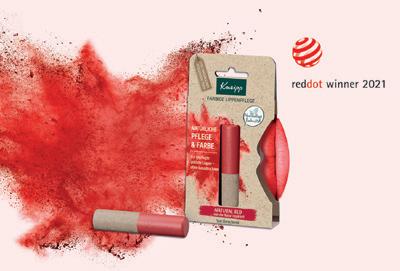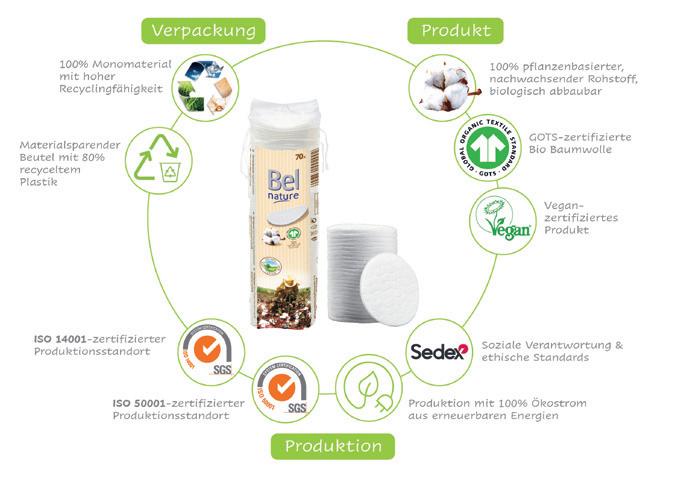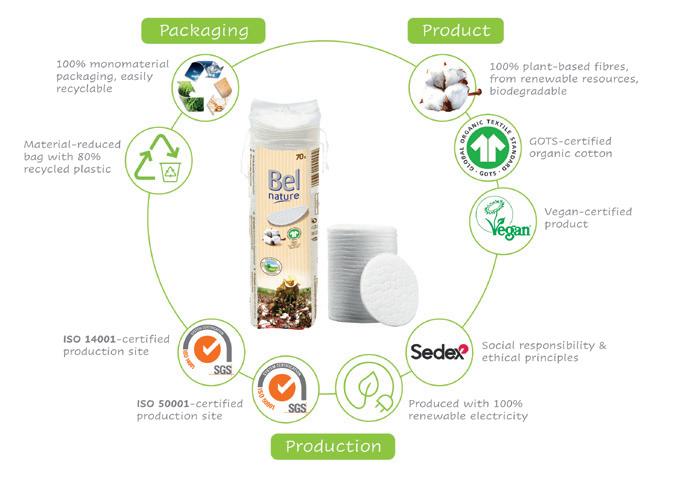
6 minute read
3.3 Environmentally friendly products
Life cycle Assessments
To provide its Product Developers with sound data for product optimization, in recent years HARTMANN has also carried out Life Cycle Assessments (LCA) and analyzed all environmental impacts in accordance with ISO 14040 and ISO 14044. The LCA results within the Incontinence Management and Risk Prevention divisions provide a basis for the further development of products aligned with sustainability goals. HARTMANN is currently further expanding the scope of the LCAs it carries out.
Advertisement
All LCAs at HARTMANN so far have identified raw material consumption as a key driver of environmental impacts. The Company plans to achieve further significant improvements in the sustainability of its products through intelligent product design. In Incontinence Management, for example, the Company is optimizing its products to reduce packaging volume, storage space, and road freight requirements.
Sustainable materials
Modifications of medical device product compositions, the materials they use and their packaging cannot be carried out quickly due to regulatory requirements. Nevertheless, HARTMANN consistently takes all possible opportunities to investigate more sustainable product solutions. The Company has implemented appropriate supply-chain certifications at its locations that work with a high volume of wood-based materials, in particular cellulose. Various locations in Germany, France, Italy, Switzerland, and Spain hold FSC® Chain of Custody certification (FSC® C131245). Appropriate product certifications are implemented wherever the market requires this.
At HARTMANN, cellulose and other pulp fibers make up the largest share of the raw material requirement. The Company sources cellulose for incontinence products mainly from North America and Scandinavia; this originates mainly from certified sustainable forestry. All cellulose is bleached free of chlorine gas: This reduces the amount of absorbable organic halogens (AOX) in pulp mill wastewater. The subsidiaries also implement sustainability measures with regard to raw materials and ingredients. For example, the shower products and soaps produced by Kneipp consist of 98% biodegradable ingredients. KOB provides latex-free dressing retention bandages as well as compression and support bandages that contain high proportions of natural fibers. CMC manufactures cotton swabs as a biodegradable product with environmentally friendly paper shafts and packaging (ISEGA Certificate ISO 13432). The cardboard boxes used by all HARTMANN Divisions consist mainly of recycled fibers. Besides the above, HARTMANN has implemented various systemic measures to save material and avoid waste. For example, in the Risk Prevention area the use of materials and packaging concepts
are continuously reviewed and optimized. Within a design-to-cost project HARTMANN has optimized the use of materials for surgical operation covers by making design changes, thus improving transport, storage and sterilization conditions.
All the cellulose used in incontinence products is bleached without chlorine gas.
Recycling and disposal at the end of the product life cycle
HARTMANN distinguishes between the disposal and recycling of used products, as well as between the reduction and recycling of production-related waste (see page 27, Raw material and waste management). For the majority of products, industrial recycling after use is not possible or only partly possible, as these come into contact with body fluids during use. However, the used products can be routed for thermal recovery and thus serve to recover energy. Within EDANA (European Disposables And Nonwovens Association) – the world’s leading nonwoven textiles association – HARTMANN is working on projects that will in future also enable the material recovery of raw materials from used hygiene products. KOB mainly uses folding cartons and shipping boxes made of 100% recycled material. In isolated cases it also uses packaging made of certified, renewable raw materials.
Sustainable packaging and transport optimization
In developing more sustainable packaging, the specific regulations for sterile medical devices need to be taken into account very carefully. HARTMANN has already launched a large number of projects and measures with the aim of continually optimizing the sustainability of its packaging. For example, CMC provides cotton pads in PE bags containing recyclate and packs a large proportion of its retail medical products in paper packaging. The Incontinence Management division already implemented packaging optimizations for its MoliCare® Bed Mats in 2020 and successfully marketed these. As a result, through packaging optimizations over 20,000 pallets were saved in the year under review, with storage and transport capacity requirements also reduced in this area. In the years to come, the Company will expand this optimization program to further Incontinence assortments.
KNeipp: Lip balm award

Natural Red colored lip balm by Kneipp, launched in March 2021, won the international Red Dot Design Award 2021. It complements the Kneipp color-free lip balm series introduced in 2019, which has itself already received several awards for its sustainable packaging concept, including the German Sustainability Award Design 2020 in the “Pioneer” category.
The cap of the colored lip balm is made of the innovative material Paper Blend and thus of 99% organic-based raw materials. Kneipp uses a mixture of Paper Blend and cork for the lower cylinder: The cork used consists of residual cork from the production of winebottle corks, among other sources. The folding carton has a grass content of 25% – a particularly fast self-renewing raw material. Furthermore, the production of grass-based paper requires around 3,000 liters less water per metric ton than commercial paper. The raw materials used for the lip balms bear the OK Compost EN13432 Certificate and can be composted under industrial conditions. In 2021 Kneipp was already awarded the independent GREEN BRAND seal for its sustainability strategy for the fifth time.
In the Disinfection division, HARTMANN successfully reduced the empty volume of the 750 ml bottle of its disinfectant Bacillol® 30 Sensitive Foam by 30 cm3 , thus reducing the volume of material required. In 2017 HARTMANN switched to using a concentrate for the production of Mikrobac® Tissues disinfection wipes, which led to savings of over 80% in transportation and other costs.
Kneipp continuously optimizes its packaging concepts and has developed a strategy for sustainable packaging. For example, this company has set itself the goal of using natural paper alternatives that do not contain virgin wood fiber. 50% of paper packaging at Kneipp has already been converted and in the current year the plan is to achieve close to 100% through further steps; from 2023, all packaging should be fully recyclable. At the same time, Kneipp is working on the independent external certification of the recyclates used in its packaging. Kneipp’s overall declared objective is to replace all plastics, including recycled plastics, with more sustainable alternatives by 2025. The strategy is already showing initial success: In 2021 Kneipp successfully reduced plastics in its packaging by approximately 26% compared to 2018.


cMc: Sustainable cotton pads
CMC is a member of Sedex, an organization of and for companies committed to continuously improving ethical behavior throughout their supply chain. CMC developed its Bel nature cotton pads based on sustainable criteria, from production, through the product itself, to packaging. The company manufactures the cotton pads at an ISO 14001 and 50001-certified production facility, and procures 100% of its electricity from renewable energy sources. The pads consist entirely of cotton, a renewable and biodegradable raw material. Additionally, this cotton is GOTS-certified: The Global Organic Textile Standard is recognized as a globally leading standard for the processing of organically produced natural fibers. The packaging is 80% recyclate and 100% recyclable, as it consists of only one material.










